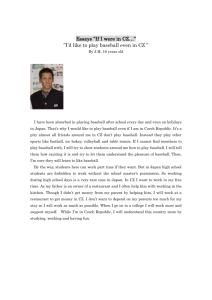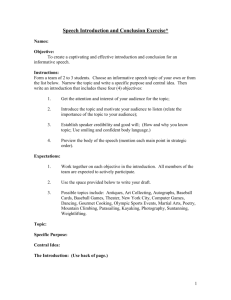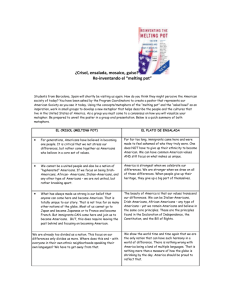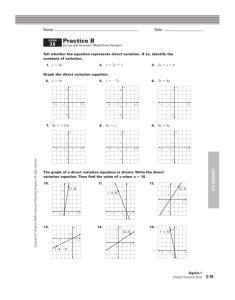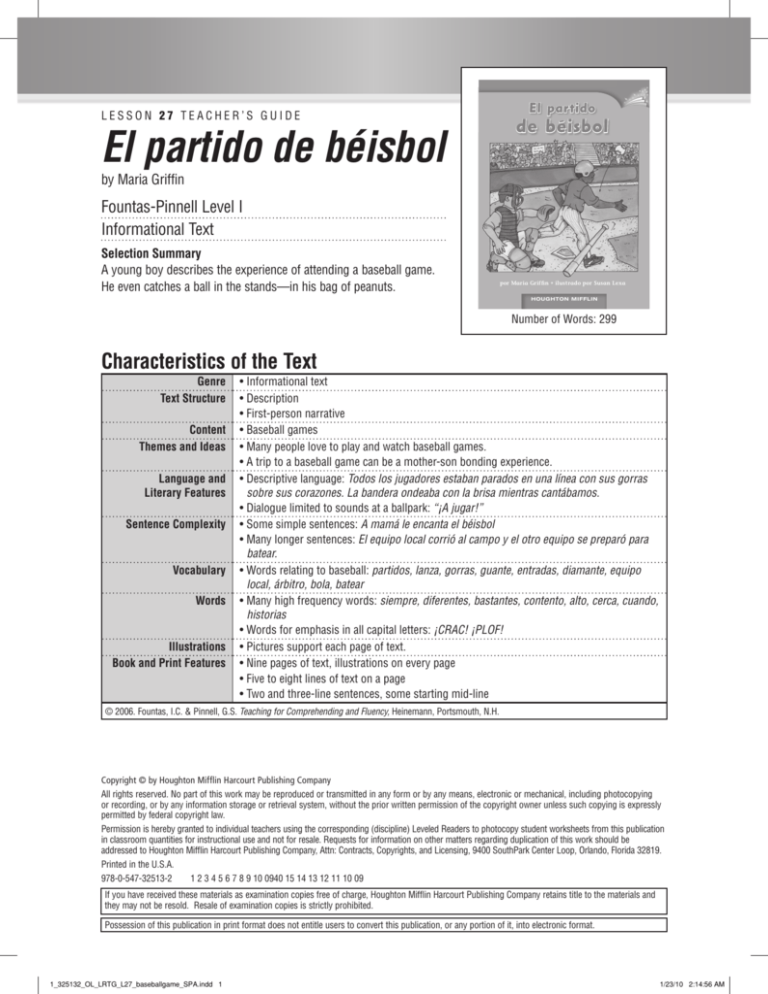
Nivel: I
EDL: 14–16
El partido
Género:
Texto informativo
Estrategia:
Analizar/Evaluar
LESSON 27 TEACHER’S GUIDE
El partido de béisbol
Destreza:
Texto y características gráficas
de béisbol
Número de palabras: 300
1.6.2
by Maria Griffin
Fountas-Pinnell Level I
Informational Text
HOUGHTON MIFFLIN
Libritos nivelados
en línea
Selection Summary
A young boy describes the experience of attending a baseball game.
He even catches a ball in the stands—in his bag of peanuts.
ISBN-13:978-0-547-03637-3
ISBN-10:0-547-03637-X
por Maria Griffin • ilustrado por Susan Lexa
1033848
H O U G H T O N MI F F L I N
1_036373_LR6_2CV_BASEB.indd 1
Number of Words: 299
4/9/08 3:00:29 PM
Characteristics of the Text
Genre
Text Structure
Content
Themes and Ideas
Language and
Literary Features
Sentence Complexity
Vocabulary
Words
Illustrations
Book and Print Features
• Informational text
• Description
• First-person narrative
• Baseball games
• Many people love to play and watch baseball games.
• A trip to a baseball game can be a mother-son bonding experience.
• Descriptive language: Todos los jugadores estaban parados en una línea con sus gorras
sobre sus corazones. La bandera ondeaba con la brisa mientras cantábamos.
• Dialogue limited to sounds at a ballpark: “¡A jugar!”
• Some simple sentences: A mamá le encanta el béisbol
• Many longer sentences: El equipo local corrió al campo y el otro equipo se preparó para
batear.
• Words relating to baseball: partidos, lanza, gorras, guante, entradas, diamante, equipo
local, árbitro, bola, batear
• Many high frequency words: siempre, diferentes, bastantes, contento, alto, cerca, cuando,
historias
• Words for emphasis in all capital letters: ¡CRAC! ¡PLOF!
• Pictures support each page of text.
• Nine pages of text, illustrations on every page
• Five to eight lines of text on a page
• Two and three-line sentences, some starting mid-line
© 2006. Fountas, I.C. & Pinnell, G.S. Teaching for Comprehending and Fluency, Heinemann, Portsmouth, N.H.
Copyright © by Houghton Mifflin Harcourt Publishing Company
All rights reserved. No part of this work may be reproduced or transmitted in any form or by any means, electronic or mechanical, including photocopying
or recording, or by any information storage or retrieval system, without the prior written permission of the copyright owner unless such copying is expressly
permitted by federal copyright law.
Permission is hereby granted to individual teachers using the corresponding (discipline) Leveled Readers to photocopy student worksheets from this publication
in classroom quantities for instructional use and not for resale. Requests for information on other matters regarding duplication of this work should be
addressed to Houghton Mifflin Harcourt Publishing Company, Attn: Contracts, Copyrights, and Licensing, 9400 SouthPark Center Loop, Orlando, Florida 32819.
Printed in the U.S.A.
978-0-547-32513-2
1 2 3 4 5 6 7 8 9 10 0940 15 14 13 12 11 10 09
If you have received these materials as examination copies free of charge, Houghton Mifflin Harcourt Publishing Company retains title to the materials and
they may not be resold. Resale of examination copies is strictly prohibited.
Possession of this publication in print format does not entitle users to convert this publication, or any portion of it, into electronic format.
1_325132_OL_LRTG_L27_baseballgame_SPA.indd 1
1/23/10 2:14:56 AM
El partido de béisbol
by Maria Griffin
Build Background
Read the title to children and ask them what is happening on the front cover. Encourage
children to use their knowledge of baseball to think about the book. Anticipate the text with
questions such as these: ¿Qué saben sobre el béisbol? ¿Alguna vez fueron a un partido de
béisbol?
Introduce the Text
Guide children through the text, noting important ideas and helping with unfamiliar
language and vocabulary so they can read the text successfully. Here are some
suggestions:
Page 2: Explain that this book tells about a boy and his mom going to a baseball
game.
Suggested language: Vayan a la ilustración de la página 2. Pueden ver al narrador
del cuento con su mamá. Ella siempre tiene historias sobre los partidos de
béisbol. Digan la palabra historias. Busquen la palabra y pongan el dedo debajo de
ella. ¿Les gusta escuchar historias sobre deportes? ¿Por qué sí? ¿Por qué no?
Page 4: Remind children that they can use information in the pictures to help them
read. ¿Dónde están el niño y su madre ahora? ¿Cómo lo saben?
Page 7: Vayan a la página 7 y miren el dibujo. ¿Qué están haciendo ahora? Había
bastantes cacahuates para los dos en esa bolsa. Digan la palabra bastantes.
¿Qué letra esperan ver al comienzo de la palabra bastantes? Busquen la palabra y
pongan el dedo debajo de ella.
Ahora, vuelvan al comienzo para descubrir las distintas cosas que pasan en un
partido de béisbol.
Words to Know
alto
cerca
cuando
historia
bastante
contento
diferente
siempre
Grade 1
2
Lesson 27: El partido de béisbol
© Houghton Mifflin Harcourt Publishing Company
1_325132_OL_LRTG_L27_baseballgame_SPA.indd 2
1/23/10 2:14:57 AM
Read
As the children read, observe them carefully. Guide them as needed, using language that
supports their problem solving ability.
Respond to the Text
Personal Response
Ask children to share their personal responses to the book. Begin by asking what they
liked about the book, or what they found most interesting.
Suggested language: ¿Les gustaría ir a un partido de béisbol como el del cuento? ¿Por
qué sí? ¿Por qué no?
Ways of Thinking
As you discuss the text, help children understand these teaching points:
Thinking Within the Text
Thinking Beyond the Text
Thinking About the Text
• Because the narrator’s mom
loves baseball, she plays
baseball in the park with him and
they go to baseball games.
• Many people love to play and
watch baseball games.
• The author uses details to tell
about the game of baseball.
• Going to a baseball game can be
an adventure.
• Information about baseball is
told in a narrative.
• The baseball field is shaped like
a diamond and everyone sings
before a game.
• You can buy peanuts at the
game, watch players hit balls,
and sometimes even catch a ball.
• Spending time together doing
something the parent loves is a
bonding experience for a child
and a parent.
© 2006. Fountas, I.C. & Pinnell, G.S. Teaching for Comprehending and Fluency, Heinemann, Portsmouth, N.H.
Choices for Support
Fluency
Invite children to choose a passage from the text to read aloud. Remind children to use
rising and falling tones in a way that is related to text meaning and punctuation. Model
how to read sentences ending with exclamation points with enthusiasm.
Phonemic Awareness and Word Work
Provide practice as needed with words and sounds, using one of the following activities:
• Clapping Syllables Have children hear and say syllables in words from the book:
entradas, jugadores, árbitro, cacahuates, equipo, contento, hambre, etc. Have them
clap on each syllable: en-tra-das, ju-ga-do-res, ár-bi-tro, ca-ca-hua-tes, e-qui-po,
con-ten-to, ham-bre, etc.
• Build Words Write these syllables on four cards: di, fe, ren, te. Guide children in
blending the four syllables by saying each syllable on the cards. Have children put the
syllables together to make a word from the story, and say the word: diferente.
Grade 1
3
Lesson 27: El partido de béisbol
© Houghton Mifflin Harcourt Publishing Company
1_325132_OL_LRTG_L27_baseballgame_SPA.indd 3
1/23/10 2:14:57 AM
Writing About Reading
Critical Thinking
Read the directions for children on Hoja reproducible 27.7 and guide them in answering
the questions.
Responding
Read aloud the questions at the back of the book and help children complete the activities.
Target Comprehension Skill
Text and Graphic Features
Remind children to think about how words
work with art. Model how to think about how the words work with the pictures:
Think Aloud
Cuando miro la ilustración de la página 2, veo a la mamá y al niño
mientras juegan al béisbol. Veo que se están divirtiendo. Entonces, sé
que el texto de esta página me va a decir cuánto les gusta el béisbol.
Practice the Skill
Have children choose another picture from the book and tell how it helps them understand
the words in the text.
Writing Prompt
Read aloud the following prompt. Have children draw and write their response, using the
writing prompt on page 6.
This book tells about many things that can happen at a baseball game. Would you like to
go to a ball game? Why? Draw a picture that shows one thing you would like to see or do
at a baseball game.
Write about why you would like to go to a baseball game.
Grade 1
4
Lesson 27: El partido de béisbol
© Houghton Mifflin Harcourt Publishing Company
1_325132_OL_LRTG_L27_baseballgame_SPA.indd 4
1/23/10 2:14:58 AM
Responder
Características
textuales y gráficas Elige dos
ilustraciones del cuento. ¿Cómo te
ayudan a entender el cuento? Haz
una tabla.
DESTREZA CLAVE
¡A platicar!
De texto a texto ¿Qué más has
leído sobre partidos? ¿Qué pasó
durante esos partidos? ¿Qué
historia te gusta más y por qué?
Lección 27
Nombre
HOJA REPRODUCIBLE 27.7
Fecha
Piénsalo
11
El partido de béisbol
Piénsalo
Escucha la pregunta. Escribe una respuesta.
Las respuestas
pueden variar.
1_036373_LR6_2OL_BEISBO_L27.indd11 11
12/8/09 10:16:17 AM
1. ¿Cuál fue la parte más emocionante del partido de béisbol?
El niño atrapó una pelota
en su bolsa de cacahuates.
Hacer conexiones Piensa en un partido u otro
lugar al que fuiste con tu familia. Escribe varias
oraciones acerca de lo que sucedió.
Lea las instrucciones a los niños.
Piénsalo
© Houghton Mifflin Harcourt Publishing Company. All rights reserved.
1_352879RTXSAN_U6_LR_TAI.indd 9
Grade 1
5
9
Grado 1, Unidad 6: ¡Tres hurras por nosotros!
8/12/09 3:32:25 AM
Lesson 27: El partido de béisbol
© Houghton Mifflin Harcourt Publishing Company
1_325132_OL_LRTG_L27_baseballgame_SPA.indd 5
1/23/10 2:14:59 AM
Nombre
Fecha
El partido de béisbol
Este libro cuenta muchas cosas que pueden
pasar en un partido de béisbol. ¿Te gustaría ir a
un partido de béisbol? ¿Por qué? Haz un dibujo que
muestre algo que te gustaría ver o hacer en un partido
de béisbol.
Escribe un párrafo sobre por qué te gustaría ir a un
partido de béisbol.
Grade 1
6
Lesson 27: El partido de béisbol
© Houghton Mifflin Harcourt Publishing Company
1_325132_OL_LRTG_L27_baseballgame_SPA.indd 6
1/23/10 2:15:01 AM
Lección 27
Nombre
Fecha
Piénsalo
HOJA REPRODUCIBLE 27.7
El partido de béisbol
Piénsalo
Escucha la pregunta. Escribe una respuesta.
1. ¿Cuál fue la parte más emocionante del partido de béisbol?
Hacer conexiones Piensa en un partido u otro
lugar al que fuiste con tu familia. Escribe varias
oraciones acerca de lo que sucedió.
Grade 1
7
Lesson 27: El partido de béisbol
© Houghton Mifflin Harcourt Publishing Company
1_325132_OL_LRTG_L27_baseballgame_SPA.indd 7
1/23/10 2:15:02 AM
Lección 27
Estudiante
HOJA REPRODUCIBLE 27.11
Fecha
El partido de béisbol
El partido de béisbol
Registro de lectura
NIVEL I
page
2
Selection Text
Errors
Self-Corrections
Accuracy Rate
Self-Correction
Rate
A Mamá le encanta el béisbol.
Cuando vamos al parque, ella
siempre me cuenta historias acerca
de los partidos que ha visto.
Mamá me lanza la pelota y yo
trato de pegarle con mi bate.
La semana pasada, Mamá y yo
3
fuimos a ver un partido de béisbol.
Nos pusimos nuestras gorras y las
camisetas rojas y amarillas. Yo
llevé mi guante para tratar de
atrapar alguna pelota.
Mamá y yo fuimos en autobús
4
al partido.
Comments:
(# words read
correctly/76 × 100)
(# errors + #
Self-Corrections/
Self-Corrections)
%
lobo
Repeated word,
sentence, or phrase
®
Omission
lobo
lobo
Grade 1
0
0
1
8
Substitution
Code
lodo
lobo
1
Self-corrects
lodo sc
lobo
0
Insertion
el
1
Word told
T
lobo
lobo
Error
1
1416420
✓
Behavior
Error
9 7 805 4 7 3 2 5 1 3 2
Read word correctly
Code
90000
Behavior
ISBN-13: 978-0-547-32513-2
ISBN-10: 0-547-32513-4
1:
Lesson 27: El partido de béisbol
© Houghton Mifflin Harcourt Publishing Company
1_325132_OL_LRTG_L27_baseballgame_SPA.indd 8
1/23/10 2:15:03 AM



